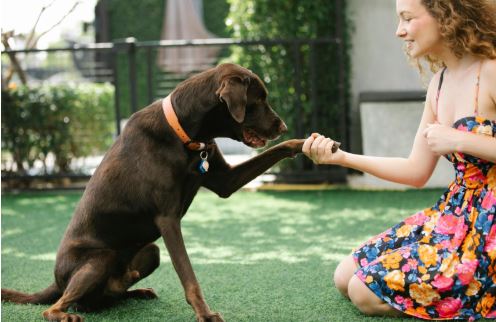Teaching Your Dog Their Name: A Simple Guide for Pet Owners
If you’ve ever tried to call a dog who stares blankly into the distance – or worse, trots off in the opposite direction – you’ll know that teaching your dog their name is one of the most valuable skills you can share with your four-legged friend. It’s not just a party trick. This simple habit builds trust, strengthens your bond, and lays the groundwork for every other bit of training to come. And in moments when safety hangs in the balance, getting your dog to respond to their name can prove downright life-saving.
The good news? This is one of the easiest skills to teach – no fancy equipment required. Whether you’re raising a plucky eight-week-old Great Dane puppy or working with a wise old Bloodhound, teaching your dog their name can begin right now, and you’ll both reap the rewards for years to come.
Why Teaching Your Dog Their Name Matters
Picture your dog’s name as the tap on the shoulder that says, “Hey, listen up – something good is coming.” When taught well, your dog’s name becomes a sound that sparks attention and eagerness, not confusion or dread.
- Builds a strong connection: Every time your dog hears their name followed by praise, affection, or tasty treats, they stitch a positive link between the sound and happy experiences.
- Forms the backbone of training: Before you can teach sit, stay, or leave it, you need to grab your dog’s attention first. A name they recognise makes this ten times easier.
- Keeps your dog safe: Out in the wide world, being able to call your dog away from a busy road, an unfriendly dog, or some unsavoury snack they’ve discovered is priceless.
So if you want a dog who listens when it matters most, this small skill packs a punch.
When to Start Teaching Their Name
Here’s the short answer: as soon as that wagging tail walks through your door.
- For puppies: Start the moment they come home – often around eight weeks old. Young pups soak up information like sponges, and this lesson sticks fast.
- For older dogs: Don’t fret if your new companion has a few grey hairs or a checkered past. Whether you’ve adopted an adult dog or are simply introducing a new name, this method works at any age.
No dog is too old to learn, and most love the chance to earn praise and goodies through such a simple task.
Step-by-Step: Teaching Your Dog Their Name
So, you’ve picked a name that suits your dog’s personality and now you’re eager to help them recognise it. The process is delightfully simple, yet it calls for patience and a generous handful of treats. Think of this as laying the first brick in the foundation of your dog’s communication with you. The key is to turn their name into a signal they’ll love to respond to.
Begin by placing yourself in a quiet room, free from distractions that might steal your dog’s attention. Have a small pile of bite-sized treats ready – ones your dog adores. Now, say your dog’s name in a tone that lifts, one that sounds cheerful and inviting. The goal here is to make your voice something they want to tune into.
The moment your dog glances your way – even if it’s just a flick of the ear or a fleeting look – reach out and offer a treat, along with warm praise. The timing matters here: reward that moment of attention straight away, so your dog links their name with good things.
Repeat this process a handful of times in short bursts. Keep sessions light and brief – perhaps a minute or two at most. You want your dog to remain engaged, not weary of the exercise. After a few successful attempts, take a break. Training should always feel like a game, not a chore.
Once your dog begins turning their head readily at the sound of their name in a quiet space, you can start to raise the stakes a little. Try practising in different rooms of the house, then gradually add gentle distractions. For instance, call their name while they are sniffing a toy, or while another person is in the room. Reward every correct response with enthusiasm and a tasty morsel.
One golden rule must always stand: never use your dog’s name in a scolding tone or during a telling-off. You want their name to be a call that promises positivity, not one that sends them slinking away. If you catch yourself about to say their name while frustrated, bite your tongue – choose another word or phrase instead.
With steady, cheerful practice, you’ll soon notice a shift. Your dog will begin whipping their head around at the sound of their name, eager to see what comes next. That’s your cue to start weaving their name into daily life – in the garden, on walks, and during games. The more you practise in different settings, the more dependable their response will become.
Common Mistakes to Avoid
While teaching your dog their name is a simple process at heart, a few common missteps can muddy the waters and slow progress. One of the biggest traps owners fall into is repeating the name over and over when the dog doesn’t respond. This turns the name into background noise rather than a signal that sparks action. If you find yourself calling your dog repeatedly with no response, pause. Reset the situation and return to practising in a quieter space where success comes more easily.
Another habit to watch closely is using the dog’s name when you’re about to correct or scold them. This is a fast way to sour the association you’ve worked so hard to build. If your dog connects their name with unpleasant outcomes, they may start ignoring it altogether – or worse, choose to avoid you when they hear it. Save their name for moments of encouragement, guidance, and affection.
Patience also plays a large role here. Many new dog owners expect instant results, especially when training a bright young pup. Yet learning takes time, and dogs thrive on consistency. Don’t be disheartened if progress feels slow at first. Keep sessions short, upbeat, and regular. Over time, you’ll see the behaviour become more natural and reliable.
By steering clear of these common pitfalls, you give your dog the best chance to form a strong, joyful connection with their name – a sound that draws them to you, ready to listen and engage.
Make It Fun and Positive
Celebrate each small success along the way. When your dog turns their head toward you in a busy park or comes running from across the garden, let them know they’ve nailed it. A smile, a cheerful voice, a well-timed treat – all of these moments reinforce the behaviour and keep learning fun.
Stay consistent, but don’t be afraid to sprinkle in variety and play. The more positive experiences your dog links to their name, the more eagerly they’ll respond – whether during quiet time at home or amid the bustle of the wider world.






